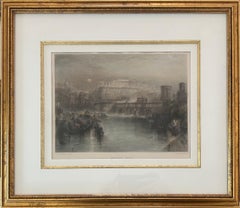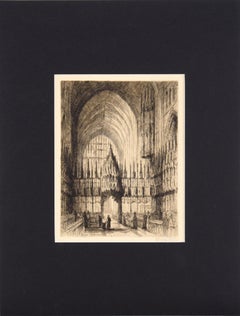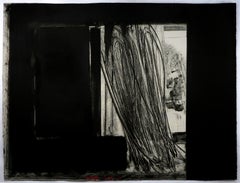Hazelton Fine Art Galleries Interior Prints
to
1
1
Overall Width
to
Overall Height
to
1
1
1
1
1
19th Century Hand Coloured Etching after 'Ancient Rome'
By (After) Joseph Mallord William Turner
Located in Toronto, ON
After William Turner's painting 'Ancient Rome; Agrippina Landing with the Ashes of Germanicus' from 1839, etched by Arthur Willmore. This scene with the moon visible dung the day is ...
Category
19th Century Romantic Interior Prints
Materials
Etching
$175 Sale Price
50% Off
Related Items
Chester Cathedral - Drypoint Etching in Ink on Paper
Located in Soquel, CA
Chester Cathedral - Drypoint Etching in Ink on Paper
Dramatic drypoint etching by J. Alphege Brewer (British, 1881-1946). This composition shows the interior of Chester Cathedral in Brewer's characteristic style - highly detailed and with strong contrast. The scene encompasses the cathedral from floor to ceiling, capturing the immense size of the building. There are several people in the scene which contribute to the sense of scale.
Signed by hand "J. Alphege Brewer" in the lower right corner.
Titled "Chester Cathedral" in plate, lower left corner.
Includes original card with artist's name.
Presented in a new black mat with foamcore backing.
Mat size: 16"H x 12"W
Paper size: 10.75"H x 7.75"W
James Alphege Brewer was well known in the early 20th century as a producer of color etchings of European cathedrals and other scenes of church, college, and community. He was born July 24, 1881, in the Kensington section of London, England, the son of Henry W. Brewer, noted artist of historical architecture and prominent convert to the Catholic Church, and the grandson of John Sherren Brewer, Jr., “the brilliant editor of the Calendar of Letters of Henry VIII.” His great uncle was E. Cobham Brewer, the polymath who compiled Brewer’s Dictionary of Phrase and Fable. Among his older siblings were the artist Henry C. Brewer and the organist and writer John Francis Brewer.
Brewer attended the Westminster School of Art in London, where his brother Henry also trained. In 1910, he married Florence Emma Lucas, an accomplished painter in oil and watercolor, whose father was the noted landscape artist George Lucas and whose great uncle was David Lucas, the famous engraver for John Constable. Florence's brothers Edwin and George assisted Brewer in the printing of Brewer's etchings.
Brewer exhibited at the Royal Academy (RA) and the Royal Institute of Painters in Watercolour (RI), at the Paris Salon of the Académie des Beaux-Arts, and in the shows of the Royal Cambrian Academy (RCA). He became an associate of the Royal Cambrian Academy in 1929 and a full member in the last two years of his life. He was also a member of the Hampstead Society of Artists, the Society of Graphic Art, and the Ealing Arts Club, where he was first Honorary Art Secretary and then Honorary Art Chairman. Most of Brewer's larger etchings were published by Alfred Bell...
Category
Early 20th Century Romantic Interior Prints
Materials
Paper, Ink, Drypoint
$396 Sale Price
20% Off
H 16 in W 12 in D 0.25 in
Howard Hodgkin hand-colored Early Evening in the Museum of Modern Art
By Howard Hodgkin
Located in New York, NY
Large scale black and white abstract interior scene with dots, lines, brushstrokes, and hand painting in grey, to hang in contemporary, modern and minimalist spaces. While British pop artists such as David Hockney and Patrick Caulfield numbered amongst Howard Hodgkin's circle of friends, Hodgkin's work is painterly, emotional, expressionist, and abstract.
Early Evening in the Museum of Modern Art, by Howard Hodgkin. Signed by the artist, numbered, and dated 79 lower center in red crayon. Soft-ground etching printed from the same plate as 'Late Afternoon in the Museum of Modern Art', with hand coloring in black gouache on Grey BFK Rives mould-made paper.
This print depicts an abstracted scene, perhaps a sculpture in front of a window in the Museum of Modern Art, Oxford, in Hodgkin's signature painterly style. The expressive mark-making in this print is an example of the artist’s movement in the late 70s towards pronounced gestures. Wide areas of deep black pigment contrast urgent swipes of ink. Always seeking greater richness in his prints, Hodgkin layered ink and hand coloring in this print, rendering each impression in the edition unique.
Part of a series of four prints reflecting on a visit to...
Category
Late 20th Century Abstract Interior Prints
Materials
Gouache, Etching
$2,250
H 29.5 in W 38.75 in
Ceiling of the Paris Opera House
By Marc Chagall
Located in Boca Raton, FL
Ceiling of the Paris Opera House
This is a print made by Center Art Galleries-Hawaii, Inc. You can google their name to get a sense of the litigation surrounding this manufacturer,...
Category
20th Century Romantic Interior Prints
Materials
Paper, Ink
Don Juan
By Louis Icart
Located in Missouri, MO
Aquating Engraving
Image Size: approx. 20 1/4 x 13 3/8
Framed Size: 28 x 20.5 inches
Pencil Signed Lower Right
Louis Justin Laurent Icart was born in Toulouse in 1890 and died in Paris in 1950. He lived in New York City in the 1920s, where he became known for his Art-Deco color etchings of glamourous women.
He was first son of Jean and Elisabeth Icart and was officially named Louis Justin Laurent Icart. The use of his initials L.I. would be sufficient in this household. Therefore, from the moment of his birth he was dubbed 'Helli'. The Icart family lived modestly in a small brick home on rue Traversière-de-la-balance, in the culturally rich Southern French city of Toulouse, which was the home of many prominent writers and artists, the most famous being Henri de Toulouse-Lautrec.
Icart entered the l'Ecole Superieure de Commerce de Toulouse in order to continue his studies for a career in business, particularly banking (his father's profession). However, he soon discovered the play writings of Victor Hugo (1802-1885), which were to change the course of his life. Icart borrowed whatever books he could find by Hugo at the Toulouse library, devouring the tales, rich in both romantic imagery and the dilemmas of the human condition. It was through Icart's love of the theater that he developed a taste for all the arts, though the urge to paint was not as yet as strong for him as the urge to act.
It was not until his move to Paris in 1907 that Icart would concentrate on painting, drawing and the production of countless beautiful etchings, which have served (more than the other mediums) to indelibly preserve his name in twentieth century art history.
Art Deco, a term coined at the 1925 Paris Exposition des Arts Decoratifs, had taken its grip on the Paris of the 1920s. By the late 1920s Icart, working for both publications and major fashion and design studios, had become very successful, both artistically and financially. His etchings reached their height of brilliance in this era of Art Deco, and Icart had become the symbol of the epoch. Yet, although Icart has created for us a picture of Paris and New York life in the 1920s and 1930s, he worked in his own style, derived principally from the study of eighteenth-century French masters such as Jean Antoine Watteau, François Boucher and Jean Honoré Fragonard.
In Icart's drawings, one sees the Impressionists Degas...
Category
1920s Art Deco Figurative Prints
Materials
Engraving, Aquatint
Interiors VI: Soundings
By Peter Milton
Located in New York, NY
Contemporary artist Peter Milton created this etching and engraving entitled "Interiors VI: Soundings" in 1989. The printed image size is 29 7/8 x 23 13/16 and paper size is 36 x 29 inches. This impression is signed, dated, and titled in pencil and inscribed “93/175” – the 93 impression of 175.
“I do love to draw. I feel that I am being granted membership in the Brotherhood of Merlin, conjuring forth some apparition. As a drawing develops, I sense a vague presence coming more and more into focus, something in a white fog emerging and becoming increasingly palpable.” – P. Milton, “The primacy of touch. The Drawings of Peter Milton”
“Working in layers, Milton begins with drawings based on people and places, with nods to Western art history and culture. He is a master of the appropriated image, a term that may conjure Andy Warhol and his Pop Art comrades. But Milton steps further back in history, avoiding the Pop sense of cool advertising and popular culture references. Instead, a broader cultural past is tapped through historical photographs of key players, architecture, and locales, which he reinvents by hand. He adds content drawn from his life as an avid reader – always with multiple possible interpretations – thus incorporating deeper meaning in his cinematic worlds. Elements of Greek mythology, classical music, art history, and history coalesce in his images, which embrace the messiness, sorrow, and elation that is life. One is hard-pressed to imagine a more erudite, skilled, passionate, and cheeky soul."
– T. L. Johnson and A. Shafer
Peter Milton was born in Pennsylvania in 1930. He studied for two years at the Virginia Military Institute...
Category
Late 20th Century Surrealist Interior Prints
Materials
Engraving, Etching
At the Cafe : Sharing a Drink - Original Etching
By Marcel Gromaire
Located in Paris, IDF
Marcel GROMAIRE (1892-1971)
At the Cafe : Sharing a Drink
Original etching
Printed signature in the plate
On vellum, 28.5 x 38 cm (c. 11 x 15 in)
INFORMATION: This etching is authe...
Category
Late 20th Century Cubist Interior Prints
Materials
Etching
ICE CREAM DESSERTS
By Claes Oldenburg
Located in Aventura, FL
Hand initialed and numbered by the artist. Etching and aquatint in colors, on handmade paper. Image size: 13.5 X 21.25 in. Sheet size: 22.5 x 31.25 in. Framed. Edition of 50. Artwor...
Category
1970s Pop Art Figurative Prints
Materials
Handmade Paper, Etching, Aquatint
Intérieur à Pressy, by Erik Desmazieres
By Erik Desmazières
Located in Palm Springs, CA
Medium: Etching, aquatint & roulette
Year: 1991
Image Size: 24.63 X 39.63 inches
Edition Size: 90
Signed and numbered in pencil by the artist
Image of a Paris apartment, showing the...
Category
1990s Contemporary Interior Prints
Materials
Etching, Aquatint
$1,400 Sale Price
43% Off
H 24.63 in W 39.63 in
Jenny Holzer, AKA: Portfolio of 5 Etchings, Contemporary Art, Signed Print
By Jenny Holzer
Located in Hamburg, DE
Jenny Holzer (American, b. 1950)
AKA, 2006
Medium: Set of five etchings, on Magnani Pescia paper (with title page, sheets loose, in original black silk-covered portfolio case)
Dimens...
Category
21st Century and Contemporary Contemporary Abstract Prints
Materials
Etching
$4,992
H 29.77 in W 22.17 in
"State 2B", Artist in the Studio Figural Etching, 1974
By Michael Pauker
Located in Soquel, CA
A wonderful small-scale etching of an artist in the studio by Michael Pauker (American, b. 1957). The artist uses fine line work to highlight this finely detailed interior figural sc...
Category
1970s Contemporary Figurative Prints
Materials
Paper, Ink, Etching
$550
H 10 in W 11 in D 0.25 in
Plan from Brodsky and Utkin: Projects 1981 - 1990, Surrealist Etching
By Alexander Brodsky and Ilya Utkin
Located in Long Island City, NY
Artist: Alexander Brodsky and Ilya Utkin, Russian (1955 - )
Title: Plan from Brodsky and Utkin: Projects 1981 - 1990
Year: 1990
Medium: Etching on German Rag paper, signed and number...
Category
1990s Conceptual Interior Prints
Materials
Etching
18th Century Etching of Ancient Roman Architectural Objects by Giovanni Piranesi
By Giovanni Battista Piranesi
Located in Alamo, CA
A. Tigna Protensa Super Media Epistylia, B. Praecisiones Tigorum Quaqua Versus Extrinsectus Apparentium, C. Opae Extremitates Tigorum Contintes, Fig. I, plate 88 from "Vasi, Candelab...
Category
Mid-18th Century Old Masters Figurative Prints
Materials
Etching
$1,975
H 25.63 in W 19.13 in D 1.25 in


